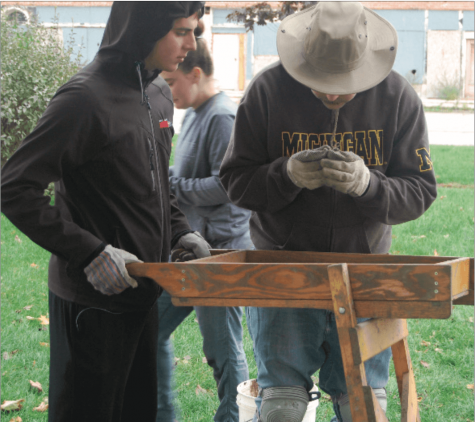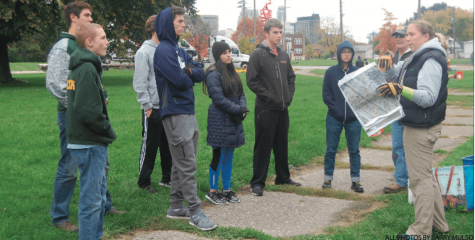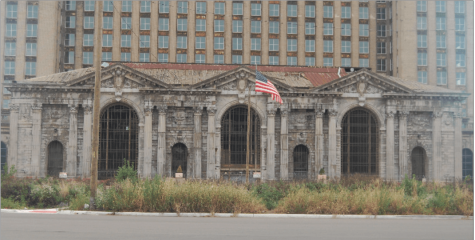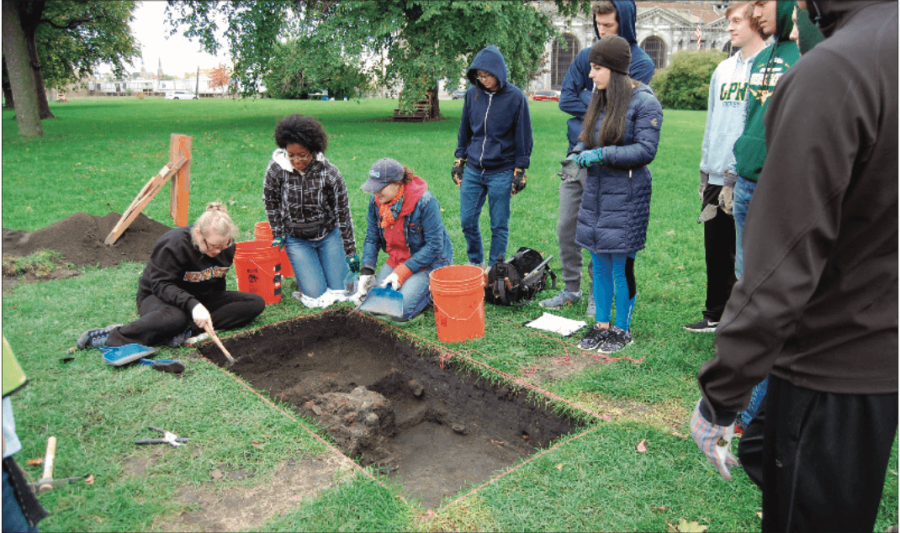Anthropology students search for artifacts in Detroit
Photo credit: Barry Mulso
DIGGING IN THE D | Anthropology students dig in hopes of nding buried artifacts. “We got down and dirty in the mud, and (we got to) really dig up some of the old past of Detroit, so it was lots of fun,” senior Garrett Clark said.
Anthropology students dug deep into Detroit’s history-rich soil hoping to find artifacts that would paint a picture of the past.
On Monday, Nov. 1, seven students joined the Wayne State University Anthropology department in its four-week-long dig at Roosevelt Park in Corktown, Detroit, home to the former Michigan Central Station.
“Things went better than I actually expected,” social studies teacher Barry Mulso said. “It was a beautiful day. The kids had a great time.”
During the 1830s-90s, many Irish households flourished in Corktown. However, after the decision to build a train station there, a large number of those dwellings were removed, leaving artifacts behind. By uncovering those remains, students were able to recreate life in Detroit back in the late 1800s.
Senior Lily Adzigian’s father, who volunteers at the digs, helped Mulso organize the trip. Mulso has taken kids on digs before, but this one was different.

SHUFFLING | After digging, senior DJ Mattes searches through the dirt looking for artifcats.
“We originally thought that we were going just to go watch them do it,” he said. “The instructor of the class wanted to involve the students in the dig, which is really cool. We are literally having some hands-on experience with it.”
Throughout the trip, students had to follow procedures that day-to-day anthropologists use to preserve artifacts they excavate. In addition, students explored physical and cultural anthropology. Both types gave students a comprehensive view of the field and what one would do as an anthropologist.
This real-world experience aided senior Garrett Clark’s understanding of what a career in anthropology is really like.
“We got down and dirty in the mud, and (we got to) really dig up some of the old past of Detroit, so it was lots of fun,” Clark said. “It (gave) me a better idea of what really being an anthropologist is like since I actually did some of the digging myself.”
During the dig, students unearthed a variety of items, like bricks, goat bones and buttons, that helped them learn more about Detroit’s history. When Adzigian discovered artifacts, she was amazed by how much paperwork was required to document the location.

LISTEN | Anthropology students gather around to listen to instructions on digging up artifacts from a Wayne State University Anthropology professor.
“It was really interesting,” she said. “It’s more of being specific of how you find stuff, and you can’t just go and dig stuff, you have to go by layers, which was kind of a surprise, and then when you find something, you can’t immediately take it out. There’s a lot more paperwork than I originally thought.”
By utilizing the fragments, students found out what people ate and owned in the past. This allowed them to further learn about the standard of living in that society. Mulso said this is a great way for students to experience what’s it like to piece together an anthropological puzzle to create a snapshot of Detroit’s past.
“This is interesting stuff,” Mulso said. “As you dig down, you start to see the layers of life that have occurred on those locations overtime, and it is just like looking at a timeline. Through the stratification of the soil, you get to see what happened over time as well. As you dig deeper, obviously artifacts will get older, and at a certain point you’re going to stop seeing those. You kind of paint a picture (of) the history of the city in that area during that time frame.”
After the trip, both Adzigian and Clark want to take an anthropology class in the future and wish to pursue it as a hobby.

ALL ABOARD | The former Michigan Central Station in Corktown Detroit, now known as Roosevelt Park, was the site of the dig.
Since only half the class went on the trip, Mulso wants more students to go in future years because it is a rare opportunity. He also hopes to repeat the trip next year because he finds many students gain a passion for anthropology when they actually experience it.
“Those real-world experiences usually translate into something solid, something concrete for people to kind of wrap their brains around,” he said. “I feel it’s my duty to kind of spur that interest and give them as much information as possible to figure out what they want to do.”
Contributing: Syeda Rizvi


